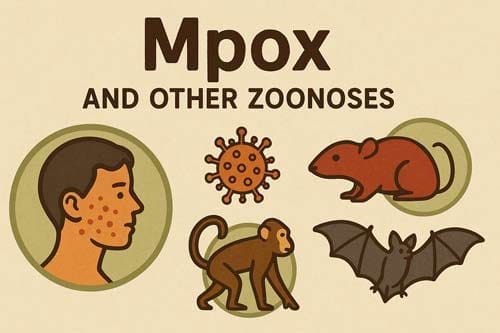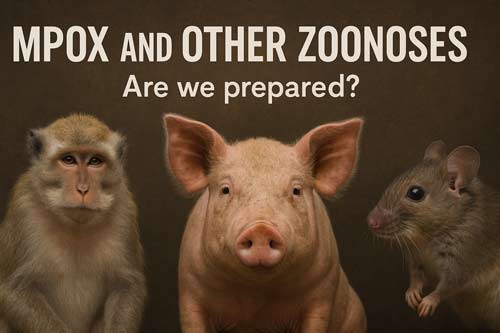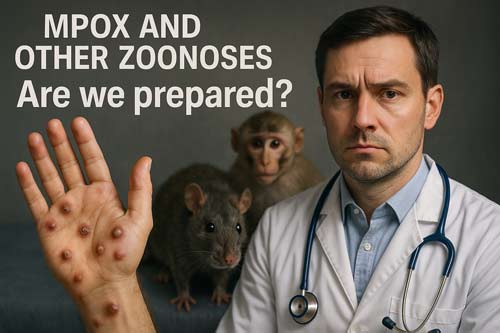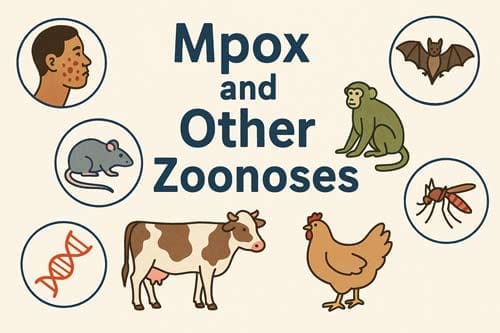Mpox and Other Zoonoses: Are We Prepared for the Next Spillover?
Abstract
This paper provides a comprehensive assessment of global preparedness for zoonotic diseases, with a focus on mpox and other emerging threats. It analyzes recent outbreaks and the drivers of zoonotic spillover, including environmental changes, human-animal interactions, and global mobility. The review evaluates current prevention and response measures—such as surveillance systems, early warning networks, and public health infrastructure—and identifies critical gaps in readiness. Emphasis is placed on the need for enhanced surveillance, cross-sector collaboration, investment in research, and coordinated international action to reduce the risk of future zoonotic events. To support practical application, a FAQ section addresses common clinical and public health questions from healthcare professionals.
Introduction
Zoonotic diseases, those transmitted from animals to humans, have long posed a challenge to global health. Historically responsible for significant outbreaks, including SARS, Ebola, and avian influenza, these diseases continue to emerge due to a combination of ecological, socioeconomic, and behavioral factors.
The recent resurgence of mpox (previously known as monkeypox) has underscored the persistent threat of zoonotic pathogens and highlighted vulnerabilities in public health preparedness. Although mpox has been known for decades, its spread beyond traditionally endemic regions signals a shift in transmission dynamics and a growing need for global vigilance.
This paper examines the current state of preparedness for zoonotic spillovers by analyzing recent epidemiological patterns, identifying contributing factors such as deforestation, wildlife trade, and urbanization, and evaluating the effectiveness of existing response strategies. Through this analysis, we aim to highlight key opportunities for strengthening surveillance systems, improving early detection, enhancing intersectoral coordination, and investing in research and development.
By providing a clear and actionable overview, this paper supports healthcare professionals, researchers, and policymakers in building more resilient health systems capable of responding effectively to the ongoing and evolving threat of zoonotic diseases.

Background on Zoonoses
Zoonotic diseases make up roughly 60% of all known infectious diseases in people. They are caused by a wide range of pathogens, including viruses, bacteria, parasites, and fungi. Common examples include rabies, Lyme disease, and various strains of influenza.
Understanding the transmission pathways of zoonoses is essential for healthcare professionals, especially when assessing atypical infections. Key transmission routes include:
- Direct contact: Touching infected animals or their bodily fluids, tissues, or excreta.
- Indirect contact: Exposure to environments or surfaces contaminated by animals (e.g., bedding, cages, soil).
- Vector-borne transmission: Spread through insect vectors such as mosquitoes (e.g., Zika virus) or ticks (e.g., Lyme disease).
- Foodborne transmission: Ingestion of undercooked or contaminated animal products, or food exposed to animal feces.
The One Health approach which emphasizes the interconnected health of humans, animals, and the environment is critical in understanding and controlling zoonotic diseases. For clinicians, this means incorporating a thorough exposure history, including animal contact and environmental factors, into patient assessments.
In recent years, several zoonotic diseases have emerged or re-emerged with significant public health implications, including:
- SARS-CoV-2 (COVID-19)
- Ebola virus disease
- Zika virus infection
- H5N1 avian influenza
These outbreaks underscore the persistent threat of zoonoses and the importance of ongoing surveillance, interdisciplinary collaboration, and preparedness in clinical and public health practice
The Mpox Outbreak
The 2022 mpox outbreak underscored the growing risk of zoonotic diseases in a highly connected world. Mpox, caused by the mpox virus (a member of the Orthopoxvirus genus), was once considered a rare disease confined to Central and West Africa. However, the 2022 outbreak marked a significant shift, with cases rapidly emerging in multiple non-endemic countries across Europe, North America, and beyond—many with no direct links to travel or animal exposure in endemic regions.
Clinical Features
Mpox typically presents with a combination of non-specific and dermatologic symptoms:
- Prodromal phase: Fever, fatigue, headache, and lymphadenopathy (a key distinguishing feature from smallpox).
- Rash: A progressive skin eruption that usually begins on the face and spreads to other parts of the body. Lesions evolve from macules to papules, vesicles, pustules, and finally scabs.
- The illness generally lasts 2 to 4 weeks and is often self-limiting, although severe cases can occur, especially in immunocompromised individuals.
Transmission Dynamics
Mpox spreads through:
- Direct contact with bodily fluids, skin lesions, or respiratory droplets of infected individuals
- Contaminated objects (e.g., bedding, clothing)
- Animal-to-human transmission, typically through bites, scratches, or preparation of bushmeat from infected animals
Notably, the 2022 outbreak showed distinct transmission patterns:
- Predominantly affected men who have sex with men (MSM), suggesting intimate skin-to-skin contact played a significant role.
- Many cases presented with atypical lesion distribution and milder systemic symptoms, complicating early recognition and diagnosis.
In summary, the 2022 mpox outbreak challenged traditional assumptions about disease containment and emphasized the need for global preparedness against emerging infectious threats.
Factors Contributing to Zoonotic Spillovers
Several factors increase the risk of zoonotic diseases spreading to humans:
- Deforestation and habitat loss: As natural habitats shrink, wildlife comes into closer contact with human populations, increasing the risk of pathogen spillover.
- Climate change: Shifting temperatures and precipitation patterns can alter the geographic range of disease vectors and reservoirs.
- Increased human-animal contact: Activities such as hunting, farming, and keeping exotic pets can facilitate zoonotic transmission.
- Global travel and trade: Rapid international movement of people and goods can quickly spread pathogens across borders.
- Urbanization: High-density living conditions can amplify disease transmission once a spillover occurs.
- Changes in agricultural practices: Intensive farming methods can create conditions favorable for pathogen evolution and spread.
For healthcare professionals, understanding these factors is crucial for risk assessment and patient education. For instance, when taking a patient history, it’s important to inquire about recent travel, animal contact, and outdoor activities.
The concept of the human-animal interface is particularly relevant. This interface includes any point where humans and animals (both domestic and wild) interact. These interactions are becoming more frequent and intense due to human population growth and encroachment into wildlife habitats.
Moreover, the rise of antimicrobial resistance in zoonotic pathogens is a growing concern. The use of antibiotics in livestock farming can lead to the development of resistant strains that can subsequently infect humans. This underscores the importance of judicious antibiotic use in both human and veterinary medicine.
Healthcare professionals should also be aware of occupational risks for zoonotic diseases. Certain professions, such as veterinarians, farmers, and wildlife researchers, have a higher risk of exposure to zoonotic pathogens. This information can guide diagnostic considerations and preventive measures for these high-risk groups.

Current Preparedness Measures
Surveillance Systems
Many countries have established systems to monitor and detect potential zoonotic outbreaks. These include:
- Disease reporting networks
- Laboratory testing capabilities
- Animal health monitoring
For healthcare professionals, these systems rely on accurate and timely reporting of suspected cases. Familiarity with local and national reporting procedures is essential.
Syndromic surveillance is an increasingly important tool. This approach monitors health-related data for early detection of disease outbreaks. It can include:
- Emergency room visits
- Over-the-counter medication sales
- School and work absenteeism
- Internet search trends
Advanced molecular techniques, such as next-generation sequencing, are now being employed for pathogen detection and characterization. These methods can rapidly identify novel pathogens and track their spread.
One Health surveillance systems are also being developed, integrating data from human, animal, and environmental health sectors. These systems can provide a more comprehensive picture of zoonotic disease risks.
For clinicians, staying informed about current surveillance data can aid in diagnosis and treatment decisions. Many public health agencies provide regular updates on disease trends and emerging threats.
Research and Development
Ongoing research efforts focus on:
- Identifying potential zoonotic threats
- Developing vaccines and treatments
- Improving diagnostic tools
Recent advances in vaccine technology, such as mRNA vaccines, have shown promise for rapid response to new zoonotic threats. Understanding these technologies can help healthcare professionals explain new interventions to patients.
Diagnostic research is focusing on developing rapid, point-of-care tests for zoonotic diseases. These could allow for faster diagnosis and treatment initiation, particularly in resource-limited settings.
Physicians should be aware of ongoing clinical trials for zoonotic disease treatments and vaccines. Participation in these trials or referring eligible patients can contribute to advancing our preparedness for future outbreaks.
Challenges in Zoonotic Disease Preparedness
While progress has been made in addressing zoonotic diseases, several persistent challenges continue to hinder effective preparedness and response efforts worldwide:
- Resource Constraints: Many low- and middle-income countries lack the financial, human, and technical resources needed to build and maintain robust disease prevention and response systems. This limits their ability to detect, report, and control zoonotic outbreaks in a timely manner.
- Surveillance Gaps: Incomplete or fragmented surveillance systems, especially at the animal-human-environment interface, make early detection and monitoring of zoonotic threats difficult. Integration of veterinary, human health, and environmental data remains a major area of need.
- Delayed Information Sharing: Timely communication of outbreak data between local, national, and international stakeholders is often slowed by bureaucratic, legal, or infrastructural barriers. These delays can compromise containment efforts and cross-border coordination.
- Underfunded Research and Development: Investment in research on emerging zoonoses, diagnostic tools, vaccines, and treatment options remains insufficient. This hinders innovation and the development of targeted interventions for high-risk regions.
- Low Public Awareness and Engagement: Public understanding of zoonotic risks and prevention strategies is limited, which undermines community-level compliance with health measures. Risk communication efforts are often reactive rather than proactive.

Recommendations for Improving Preparedness
To effectively reduce the risk and impact of future zoonotic spillovers, a coordinated, proactive, and well-resourced approach is essential. The following key strategies are recommended:
- Strengthen Global Surveillance Systems
Invest in integrated, real-time surveillance networks that monitor both human and animal populations. This includes improving early detection systems, enhancing data sharing across borders, and leveraging digital tools and artificial intelligence to identify emerging threats before they escalate. - Increase Investment in Zoonotic Disease Research
Expand funding for interdisciplinary research focused on zoonotic pathogens, including their transmission dynamics, environmental drivers, and potential for human-to-human spread. Support the development of predictive models, vaccines, diagnostics, and therapeutics to prepare for high-risk pathogens. - Foster Cross-Sector Collaboration
Promote the One Health approach by improving coordination between public health, veterinary, environmental, and agricultural sectors. Establish joint protocols, communication channels, and shared responsibilities for outbreak prevention, detection, and response. - Enhance Public Awareness and Risk Communication
Develop targeted education campaigns to inform communities, particularly those in high-risk areas, about zoonotic disease risks and prevention measures. Use culturally appropriate messaging and engage local stakeholders to build trust and encourage behavioral change. - Build Rapid Response Capacity
Establish agile response teams and emergency frameworks capable of mobilizing quickly in the face of an outbreak. Ensure adequate stockpiles of medical supplies, streamlined regulatory pathways for emergency interventions, and clear contingency plans for containment and mitigation.


Conclusion
Although notable strides have been made in preparing for zoonotic disease outbreaks, the recent mpox (monkeypox) outbreak has underscored persistent gaps in our global and national response systems. It highlighted the need for faster detection, more coordinated surveillance, equitable access to diagnostics and vaccines, and clearer risk communication. Strengthening intersectoral collaboration, particularly between human, animal, and environmental health sectors is essential for a truly effective One Health approach.
By addressing these ongoing challenges and implementing evidence-based strategies, we can build more resilient health systems capable of responding swiftly and effectively to emerging zoonotic threats. Proactive investment in preparedness, research, and public health infrastructure will not only improve outcomes in future outbreaks but also reduce the overall burden of infectious diseases on global health.
Frequently Asked Questions:
FAQs for Healthcare Professionals
- Q: How can I distinguish mpox from other rash-causing illnesses?
A: Mpox typically presents with a characteristic rash that progresses from macules to papules, vesicles, and pustules before scabbing over. Unlike chickenpox, mpox lesions are often at the same stage of development.
- Q: What personal protective equipment (PPE) should be used when treating suspected mpox cases?
A: Healthcare workers should use gowns, gloves, eye protection, and respirators (N95 or equivalent) when caring for suspected or confirmed mpox patients.
- Q: How long should patients with mpox be isolated?
A: Patients should be isolated until all lesions have crusted over, fallen off, and a fresh layer of skin has formed underneath. This typically takes 2-4 weeks.
- Q: Are there any approved treatments for mpox?
A: While there are no specific treatments approved for mpox, antivirals developed for smallpox, such as tecovirimat, may be used in severe cases.
- Q: How can we improve early detection of zoonotic outbreaks in clinical settings?
A: Healthcare professionals should maintain a high index of suspicion for unusual presentations of illness, especially in patients with recent travel history or animal contact. Prompt reporting of suspected cases to public health authorities is crucial.
References:
Centers for Disease Control and Prevention. (2022). Monkeypox. Retrieved from https://www.cdc.gov/poxvirus/monkeypox/index.html
World Health Organization. (2022). Monkeypox. Retrieved from https://www.who.int/health-topics/monkeypox
Jones, K. E., Patel, N. G., Levy, M. A., Storeygard, A., Balk, D., Gittleman, J. L., & Daszak, P. (2008). Global trends in emerging infectious diseases. Nature, 451(7181), 990-993.
Karesh, W. B., Dobson, A., Lloyd-Smith, J. O., Lubroth, J., Dixon, M. A., Bennett, M., … & Heymann, D. L. (2012). Ecology of zoonoses: natural and unnatural histories. The Lancet, 380(9857), 1936-1945.
Allen, T., Murray, K. A., Zambrana-Torrelio, C., Morse, S. S., Rondinini, C., Di Marco, M., … & Daszak, P. (2017). Global hotspots and correlates of emerging zoonotic diseases. Nature communications, 8(1), 1-10.

